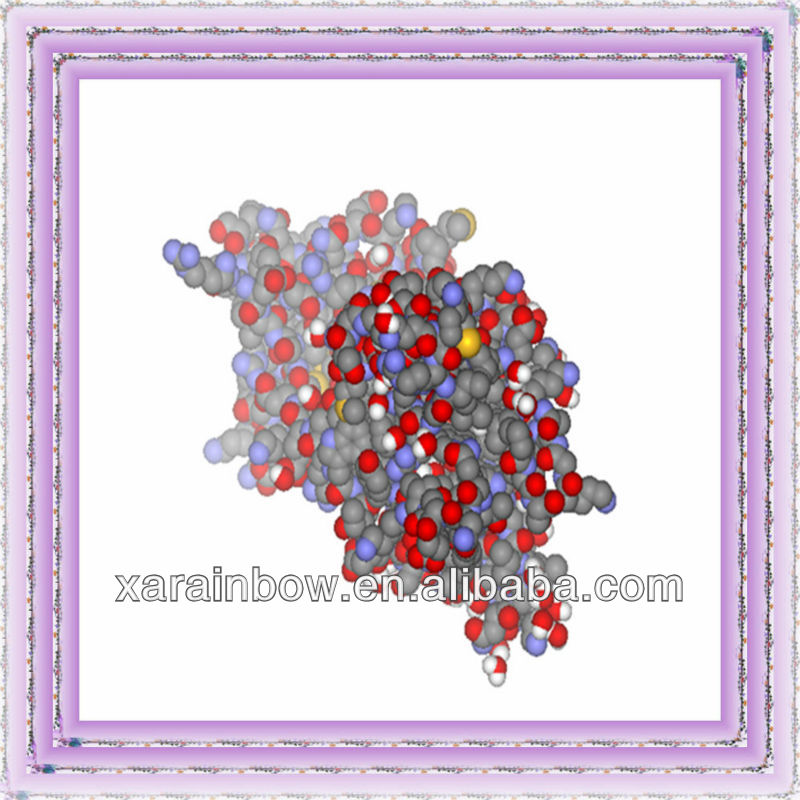
|

1Strict quality contral and best price.
2be exported to more than 50 countries.
3On time service
4high degree of credit
D-Aspartic Acid
D-Aspartic Acid
CAS Number: 1783-96-6
EINECS No: 217-234-6
Synonyms: (R)- 2- Aminosuccinic acid; D-2-Aminobutanedioic acid;
D-aspartic (d-asp) acid acts as a neurotrasmitter or neuromodulator. Aspartic acid is important in the development of nervous sytem. It is also a component of synaptic vesicles, which transmit nerve impulses between nerve cells. Aspartic acid increases cAMP levels (a secondary messenger, signal transporter between the cell surface to inside the cell).
D-aspartic acid is formed when the enzyme aspartate racemase converts L-aspartic acid into D-aspartic acid in the testes and other glands within the body. D-aspartic acid plays a vital role in the manufacturing of sperm cells and sex hormone production. Human studies have shown a significant increase in luteinizing hormone (LH), a messenger hormone that signals the testes to produce more testosterone, and a correlation to boosting testosterone levels in men when supplementing D-aspartic acid.
Aspartic acid also plays a role in the neuroendocrine system, as a regulator in the synthesis and release of hormones.
In the pituitary gland, aspartic amino acid stimulates the secretion of the following hormones:
Aspartic acid aids the functioning of all cells and RNA and DNA (carriers of the genetic code). Additional benefit of aspartic amino acid is protection of the liver from damages that can be caused by excess ammonia in the bloodstream, by helping in the removal of excess ammonia. Ammonia is toxic when in high levels in the bloodstream. Aspartic acid is involved in the urea cycle, conversion of ammonia into urea (less toxic) and its excretion. This is very important for athletes. Removal of excess ammonia also protects the central nervous system from damage.
Aspartic acid also participates in gluconeogenesis, the synthesis of glucose.
The d-aspartic acid form also plays a role in the development of dentin, a tissue that is an important component of teeth.
CERTIFICATE OF ANALYSIS
|
|
PRODUCT NAME |
D-aspartic acid |
Standard |
AJI92 |
||||||
|
|
BATCH NO |
20100303 |
QUANTITY |
500kgs |
||||||
| MANU Date |
2010-3-3 |
TEST DATE |
2010-3-3 |
|
||||||
| Analysis Item |
Analysis Standard |
Analysis Results |
|
|||||||
| Appearance |
White Powder or white crystalline powder |
Complies |
|
|||||||
| Assay |
99.0% ~ 101.0% |
99.1% |
|
|||||||
Specific rotation [α] D 20 |
-24.5° ~ -25.5° |
-25.25° |
|
|||||||
| Transmittance |
≥98.0% |
98.5% |
|
|||||||
| Iron (Fe) |
≤0.001% |
<0.001% |
|
|||||||
| Ammonium (NH 4 ) |
≤0.02% |
<0.02% |
|
|||||||
| Arsenic (As 2 O 3 ) |
≤1ppm |
<1ppm |
|
|||||||
| Sulfate (SO 4 ) |
≤0.02% |
<0.02% |
|
|||||||
Chloride (Cl) |
≤0.02% |
<0.02% |
|
|||||||
| Heavy metals (Pb) |
≤10ppm |
<10ppm |
|
|||||||
| Loss on drying |
≤0.20% |
0.06% |
|
|||||||
| Residue on ignition |
≤0.10% |
0.08% |
|
|||||||
| Other Amino acids |
≤0.30% |
<0.30% |
|
|||||||
| PH |
2.5 ~ 3.5 |
2.83 |
|
|||||||
| CAS No.: |
1783-96-6
|
Other Names: |
(R)- 2- Aminosuccinic acid
|
MF: |
C4H7NO4
|
| EINECS No.: |
217-234-6
|
FEMA No.: |
68543550
|
Place of Origin: |
Shaanxi China (Mainland)
|
| Type: |
Amino acids Pharmaceutical Intermediates
|
Brand Name: |
Xi'an Rainbow
|
Model Number: |
99% to 101.0%
|
| CAS :: |
1783-96-6
|
